Farmer reports and the word on the ground is that many are seeing increased cases of summer scour syndrome in calves this year.
Although an infectious cause for the disease has not yet been identified, it is thought to be related to nutritional issues, especially when the rumen is insufficiently developed to digest forage.
Summer scour is identified in calves in their first year grazing and usually occurs when grazing lush pastures with a high crude protein over 20% and a low fibre content of less than 40%/kg of dry matter (DM) ingested.
High growth rates throughout the summer months has led to a lot of topping, taking out paddocks for bales and pre-mowing and so, getting quality grass ahead of animals for the most part has not been an issue.
The problem with calves is that an abundance of quality lush grass ahead of them can lead to summer scour, as they are selective grazers. If they have an abundance of grass ahead of them, they will pick out the leafy, lush stuff and leave the stem.
The leafier part of the grass contains more nitrogen and non-protein nitrogen (NPN). When this is consumed in large quantities by young calves with an immature rumen, it will lead to an excessive build-up of ammonia in the rumen.
Unstable pH is another knock-on effect of inadequate rumen development, which may lead to the calf getting summer scour

Signs of summer scour syndrome include: scour, rapid weight loss, lethargy, lack of rumination and weakness. Other infestations or infections need to be ruled out before a diagnosis as summer scour.
Farmers should consult their vet when these signs are evident as coccidiosis, a high worm burden, mineral issues such as molybdenum toxicity and copper toxicity, rumen acidosis, salmonellosis and bovine viral diarrhoea (BVD) all show similar signs
Preventing summer scour
As calves are unable to handle high-quality grass, allow access to more fibre – calves that are grazing on more fibrous grass rarely suffer from the disease.
A practical way of correcting the fibre deficit for calves is to introduce hay or straw into their diet while they are out at grass.
When calves are first turned out to grass, they should continue to receive about 1.5-2kg of meal for the first five to six weeks to transition them fully to grass.
Making any dietary changes should be avoided, as it will only cause stress on the calf and take the animal longer to adjust.

Strip grazing calves is another possible method to prevent the onset of summer scour, as it will encourage them to graze both the leaf and the stem of the grass.
Calves should be let out to paddocks of covers less than 1,000kg DM/ha as these covers will encourage intakes.
Strip grazing, keeping low covers ahead of them, having access to fibre in a feeder through a bale of hay or straw, and of course access to water, along with a consistent feeding regime, should pave the way for a well-balanced diet and good health in grazing calves at this time of year.
Calves thrive off consistency and any drastic changes will cause stress, so this needs to be considered over the course of the next few weeks when considering cutting back meal or moving calves to another paddock.

